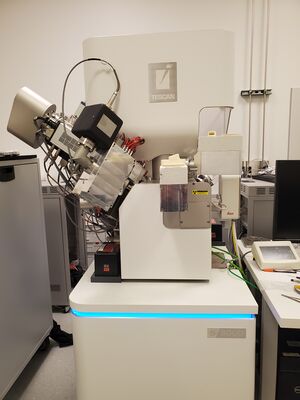Difference between revisions of "TESCAN S8000X FIB/SEM"
(added SOP link) |
|||
| Line 13: | Line 13: | ||
| NEMO_Designation = TESCAN S8000X Plasma FIB | | NEMO_Designation = TESCAN S8000X Plasma FIB | ||
| Lab_Phone = XXXXX | | Lab_Phone = XXXXX | ||
| − | | SOP Link = | + | | SOP Link = [https://docs.google.com/document/d/1qIlr6CCq-emf9hGmN1KmVK9YRDbW2GvPb3tLOEYPpVU/edit?usp=sharing pFIB SOP] |
}} | }} | ||
Latest revision as of 15:16, 11 October 2024
 |
|
| Tool Name | TESCAN S8000X FIB/SEM |
|---|---|
| Instrument Type | pFIB |
| Staff Manager | Jamie Ford |
| Lab Location | 007 |
| Tool Manufacturer | TESCAN |
| Tool Model | S8000X |
| NEMO Designation | TESCAN S8000X Plasma FIB |
| Lab Phone | XXXXX |
| SOP Link | pFIB SOP |
Description
The TESCAN S8000X combines a plasma-source focused ion beam microscope and a high- resolution (BrightBeam) scanning electron microscope. The FIB microscope is equipped with a Xe+ ion plasma source and will include additional gases in the near future. The Xe plasma can generate a focused beam up to 1 uA, which allows very high milling rates (up to 50X faster than the prior Ga+ ion technology) and does not lead to deleterious ion implantation in the same way that Ga+ ions do. The BrightBeam SEM is a field-free, ultra-high resolution electron microscope whose optics allow improved resolution, even at low energies. This improves imaging of non-conducting samples.
Applications
The instrument is equipped with a Time-of-Flight Secondary Ion Mass Spectrometery (ToF-SIMS) that can detect the ions emitted from the sample, allowing chemical characterization. ToF-SIMS is especially useful in detecting light elements, including the discrimination of hydrogen and deuterium.
An Energy Dispersive x-ray spectrometer allows for additional, complementary chemical characterization.
The S8000X is also equipped with a cryogenic stage and a sample transfer loadlock, allowing work down to -160 C or introduction of frozen samples into the tool to be milled. A cryogenic Kleindiek nanomanipulator enables users to interact with the sample in-situ as well as lift-out frozen sections for subsequent TEM analysis.
This instrument was purchased with support from a National Science Foundations’ Major Research Instrumentation grant (NSF MRI #1828545). Additional support from the Laboratory for Research on the Structure of Matter (University of Pennsylvania Materials Research Science and Engineering Center (MRSEC) (DMR-1720530).